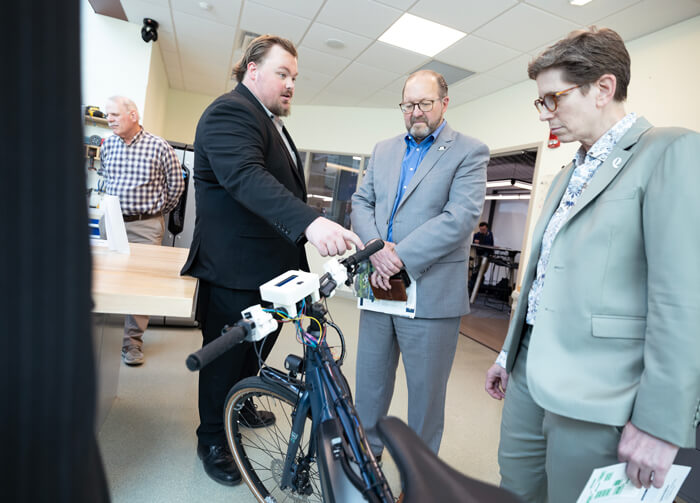
Inspiring 2025 Projects Day celebrates student innovation in computing and engineering
May 19, 2025

May 19, 2025

Dean Taskin Kocak welcomed friends, industry partners, alumni and supporters to the School of Computing and Engineering on May 7 for 2025 Projects Day.
“Today is a celebration of student innovation, problem-solving and proficiency. Our students have worked incredibly hard to bring their ideas to life and I hope you leave here both inspired and impressed by what they have accomplished,” said Kocak.
Kocak also expressed Quinnipiac’s deep appreciation for the vital support Projects Day partners supply as project sponsors and student mentors helping to guide student success.
Assistant Dean for Student Experience and Career Development/Projects Day Committee Chair John Bau thanked Connecticut Chief Manufacturing Officer Paul Lavoie for attending Projects Day to meet with students and learn more about their work.
“Paul Lavoie is a tireless advocate for technical education and for technical workforce in our state,” said Bau.
Bau also thanked Provost Debra Liebowitz for supporting Projects Day and recognized the formative work of Professor of Mechanical Engineering Grant Crawford for establishing Projects Day at Quinnipiac ten years ago.
Bau encouraged all attendees to ask questions and hear first-hand from students about the exceptional work comprising 35 projects in computer science, software engineering, civil engineering, mechanical engineering and industrial engineering.
As one of four unique industrial engineering projects being showcased, the team of Derrick Zevola, ’25, Kyle Yusi, ’25 and Thomas Hopkins, ’25 developed a manufacturing conveyor system utilizing physical and digital models and integrating key automation robotics. Their project partner was Gibson Engineering.
“Effectively what we wanted to do was build a manufacturing system utilizing all the robots here. The MiR 100 is for autonomous logistics transport, the YuMi ABB robot does assembly tasks and the UR10e robot does product sorting,” said Zevola. “We built a framework for the system to be possible in the physical world, and on top of that, we wanted to create a framework for a digital twin which is effectively going to help us answer those ‘what if’ questions, running simulations within hours as opposed to days.”
Hopkins said the project gave the team hands-on experience and insight into applications of Industry 4.0, which involves using advanced robotics for autonomous tasks.
Yusi said the project can also help Quinnipiac move toward becoming a university recognized by CESMII/The Smart Manufacturing Institute as Smart Manufacturing Innovation Center.
“There are only a handful of Smart Manufacturing Centers within the United States recognized by CESMII. At Quinnipiac University, we’re trying to pursue to that level and to be more competitive, to really differentiate Quinnipiac among its peers,” said Yusi.
Computer Science majors Harsh Gandhi ’25, Andrew Kulowski, ’25 and Brian Wanamaker ’25, presented another transformative project, “AirBoard: AI Powered Whiteboard.” Their gesture-based controlled virtual whiteboard lets users write, draw, and interact with digital content through natural hand movements. The team developed a versatile desktop application that operates on any computer with a camera, transforming hand gestures into digital writing and drawing in real-time.
“One of the main reasons we built this was to assist teachers who are teaching remotely, and also if a teacher is disabled and can’t stand for long to write on a whiteboard, they can use our solution to teach,” said Gandhi.
Together with their advisement group including Associate Professors of Computer Science Chetan Jaiswal and Brian O’Neill; Assistant Professor of Software Engineering Kruti Shah; and Director of Faculty Advancement in Teaching Excellence Sara Rzeszutek, the team is writing a research paper that’s headed for publication and will present a poster at an upcoming Institute of Electrical and Electronics Engineers Conference in Seattle, Washington.
“We definitely could not have done it without our advisors,” said Wanamaker. “It’s been year-long project, and we met with them twice a week. Whether it was helping with next steps, helping with the paper, or testing it throughout the semesters, they guided us every step of the way.”
The AirBoard project was one of seven exceptional novel concepts developed by teams of Computer Science BS majors sharing their work on Projects Day.
“I think the students are producing extremely high-quality work, and for most of the work, there’s no comparison out there,” said Jaiswal. “The only objective I have for them is if the idea is feasible for them to accomplish in two semesters; because my job is to also look at the realistic nature of these implementations.”
Computer Science BS majors Garrett Goldberg ’25, Andrew Labbe ’25 and Mia Troiano ’25 developed ClaimCraft, an open-world exploration game and insurance education tool.
“Our goal was to take a swing on turning education into a game, which has been super relevant recently,” said Goldberg. “All three of us are going to work in insurance after graduation, and a big concern was that there was a lack of education in the younger demographic. So our game has players taking the point of view of an insurance claim adjuster and you go through day-to-day tasks. In 30 minutes of playtime, you know everything you need to know about insurance, coming out of college.”
Additionally, 12 Computer Science research projects were presented on Projects Day. The BA students were advised by Jonathan Blake, professor of computer science and software engineering.
“This is my favorite day of the year,” said Blake. “Every year, we get a new crop of first-year students who look at things like this and say, ‘There’s no way I’ll ever be able to do that.’ And three and half years later, they’re standing in front of posters that demonstrate they’re experts about something. There’s no better example of the growth our students go through than this day.”
Riley Damasco focused his project on “Immersive Technologies in Context: A Comparative Study of AR, VR and Flatscreen Interfaces in Education, Healthcare and Workplace Training.”
Damasco’s research explored how Augmented Reality (AR), Virtual Reality (VR) and flatscreen technologies are being used in education, healthcare and workplace training.
“It focuses on how each technology performs regarding user engagement, effectiveness and adaptability depending on the context,” said Damasco.
With his project, “Enhancing Collaboration and Creativity through Human-AI Synergy,” Philip Nora explored the potential of AI in fostering collaboration, creativity and innovation within organizational settings.
“I thought it was a pretty interesting subject, and I fell in love with how helpful AI can be with everyday use,” said Nora. “I focused on the business side of it — collaboration, brainstorming, how can we automate some of these tasks and make our lives a little bit easier; and how much more productive companies can get.”
Two software engineering projects were shared on Projects Day. Software engineering majors SeSe Allerheiligen, Eric Carlson, Steven Griffin and Camryn Keller created Bobcat Tracks, a software application and website providing insightful analysis of student and peer mentoring data to help the Learning Commons drive student success.
Software engineering majors Charlize Aponte, Dylan Bellinger, Gabriella Pierce and Kevin Rodriguez developed an Electronic Healthcare Record application to help streamline practice simulation labs for School of Nursing students and faculty.
“The goal of the application is to integrate the features that were in an Excel-based system into a web application so it can be easily accessible for any user within the School of Nursing, allow administrators to add any necessary information, and for student nurses to document any relevant information,” said Rodriguez.
The Town of Hamden was the client for civil engineering majors Jenna Castro, Aidan Ceravolo, Natalie Lyon, Abigail Palmgren and Lauren Roeger. Their senior design project focused on the structural design of Hamden’s first animal shelter, applying structural engineering principles in a real-world setting.
“We focused in on site design initially, from there our team took the site design plan to an architectural layout, and then we were able to 3-D render it in structural software,” said Palmgren.
Castro said the Town of Hamden accepted their final design and is submitting it for funding to move forward with constructing the shelter.
“It does feel good to have our work accepted,” said Lyon.
For the City of New Haven, civil engineering majors Alexander Asfalg, Ryan Connolly, Kenneth Stolgitis, Steven Tortora tackled a section of road prone to frequent flooding.
“The problem is the road is prone to blue-sky flooding. When the tides are high, the water from the Quinnipiac River floods through multiple culverts and catch basins and floods the road,” said Stolgitis. “We’re installing sluice gates on each culvert combined with Opti, a Cloud-based stormwater management system. When tides higher than four feet are predicted, it will close the gates automatically so it will prevent the road from flooding.”
The team’s design also included a levee system composed of different soils, concrete supports and geotextiles as well as a detention pond to retain excess stormwater.
“This is a project that is a real problem that needs a real solution,” said Tortora, who focused on the levee system.
“Working on this project was a great opportunity for us,” said Asfalg. “The City of New Haven wanted to get starting point on this project, and we were able to get real-world experience working on it.”
Connolly’s work on the detention pond included calculating and incorporating flood prevention measures to withstand a two-year, 24-hour storm. He said the experience has already started conversations with prospective employers.
“I had an interview the other day and they were asking me all kinds of questions on this. I am going to gear my career more toward structural engineering, but this project provided me valuable lessons about teamwork and other aspects of engineering that I haven’t gotten in my three and half years here,” said Connolly.
Two mechanical engineering projects served to assist a single client, The Devil’s Gear Bike Shop of New Haven. One Electric Bike Safety Team of mechanical engineering majors Jonathan Gold, Evan Jones, Ian Vanriper focused on improving the e-bike's responsiveness, sensitivity, external noticeability, user noticeability and clarity. They developed a developed a unique front and rear mounted system involving haptic sensor technology to enhance the protection and awareness of electric bike riders.
“There’s not a lot with haptic feedback on the market like this. I don’t think I’ve ever seen it before on a bike,” said Gold.
A second Electric Bike Safety team of mechanical engineering majors Nazim Ahmed, Matthew Castano and Jason Vassilakis were tasked with developing an advanced e-bike safety system with key customer requirements including ensuring user stability, control intuitiveness, system reliability, structural durability and modularity.
Ahmed retrofitted anti-lock brakes and sensor activated anti-collision brakes for an e-bike as his project contribution. Castano and Vassilakis focused on developing an auto-deployable kickstand.
“One of the issues we had was finding our actual activation method that would adhere to our requirements, and eventually we arrived at the torsional spring system,” said Castano.
“A lot of our iterations were done with 3-D printing, and then when we ultimately found the design that worked best, we started machining with aluminum and created all the custom parts,” said Vassilakis.
Liebowitz said Projects Day immerses School of Computing and Engineering students in an exceptional learning experience as they prepare to enter their careers.
“They’re getting to work on real-world problems by taking what they’ve learned and applying it to complicated tasks; and often they’re thinking about how to do that as a team. Those are the things they need to be successful when they leave Quinnipiac,” Liebowitz said. “And some of what they’ve done is extraordinary. The projects have the possibility to transform the industries or the work that they’re doing; and they’re only beginning.”
Quinnipiac Today is your source for what's happening throughout #BobcatNation. Sign up for our weekly email newsletter to be among the first to know about news, events and members of our Bobcat family who are making a positive difference in our world.
Sign Up Now